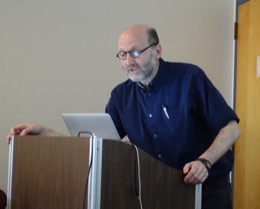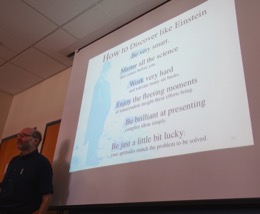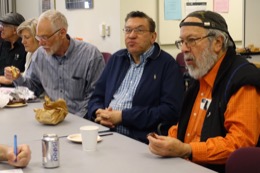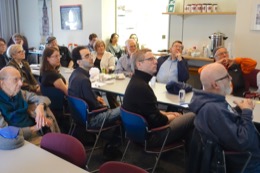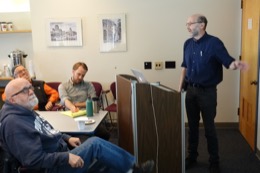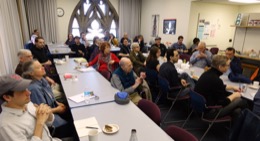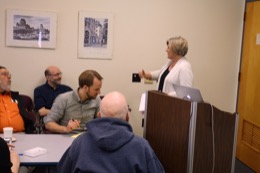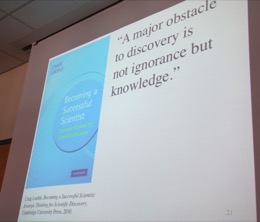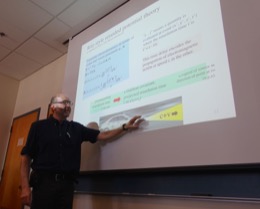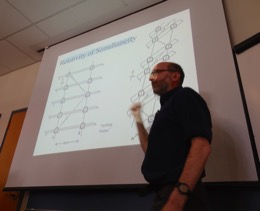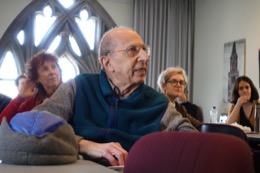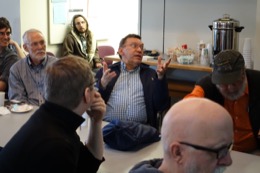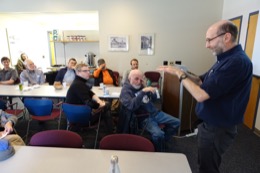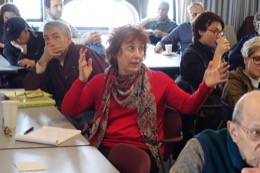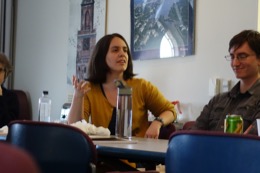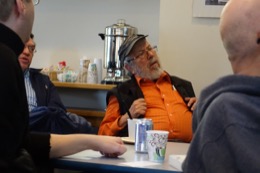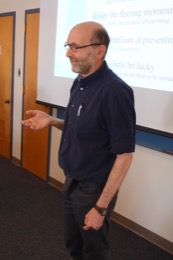
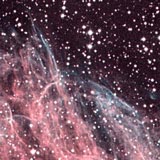
![]()
home
::: about
::: news
::: links
::: giving
::: contact
![]()
events
::: calendar
::: lunchtime
::: annual
lecture series
::: conferences
![]()
people
::: visiting fellows
::: postdoc fellows
::: resident fellows
::: associates
![]()
joining
::: visiting fellowships
::: postdoc fellowships
::: senior fellowships
::: resident fellowships
::: associateships
![]()
being here
::: visiting
::: the last donut
::: photo album
|
Einstein Myths
“I’m nervous about this talk,” I said as I faced the room in our lunchtime talk series. “I have to give it in a few prominent places, but I’m not sure if it works. So I thought I’d try it out with a kind and friendly audience.” I paused for a moment to let my plea percolate. And then: “You are a kind and friendly audience, aren’t you?” My hope was that this would set the mood. I was genuinely worried. On the bus ride in to the University, I had sat staring out of the window, worrying. I suddenly feared that the order of presentation of the ideas was just wrong. A proper job, I worried, would have to turn everything inside out. I didn’t have time to do that before the noontime talk. The die was cast and the decision made. I would have to go with what I had and hope for the best: a kind and friendly audience. I spent some time in the morning tinkering. I added a strong positive concluding slide: and funny graphic that underscored the incongruity of Einstein instructing us on how to read clocks in his famous 1905 paper on special relativity.
My mood was not helped as the room filled. I found Ted Newman and Tony Duncan, luminaries from the physics department, experts in relativity and quantum theory, sitting at the front, working their way through their lunches. Next to them was John Earman. I felt something like a flightless bird about to give flying lessons, when eagles show up in the class. “Well,” I thought, “If I survive this, I’m ready for anything.” The talk is an outcome of my studies of Einstein’s discoveries. They have been driven by a compulsion to answer the question of just how he could do what he did. The answers are never simple. Discovery at Einstein’s level is complex and takes time. However penetrating it has been immensely rewarding. From a distance, his discoveries can look like magic. Close up, you learn that Einstein had no magic wand. His tools were the same as everyone else’s, yet he used them so well that the results appear magical. I love to tell stories about how Einstein discovered: his years grappling with a problem, the dark nights of despair, the renewed efforts and then the brilliant moment when it all comes together. I am not the only one. There is a large, popular literature devoted to revealing how Einstein did what he did. Alas, much of this popular literature in bunk. It is full of poorly researched pronouncements, hasty generalizations, wishful thinking and sometimes direct fabrication. That literature is my target. I have four myths to recount, and I am going to pair them with two case studies: Einstein’s discovery of special relativity and his positing of the light quantum. My hope is that I can both debunk the myths while at the same time giving some sense of the real process through which Einstein went to his discoveries. ———————— It was time to start. Nancy Nersessian, our Senior Visiting Fellow this year, took on the job of introducing me. She did a lovely job. She recalled that we’d first met in 1985 when she had been a Visiting Fellow in the Center. It was a moment I still recall with happiness-—we have been good friends ever since. Then I took the floor and explained my concerns. “This is a trial to see if I can present this without coming off as mean-spirited.” Soon I was buried in one of the most popular myths: that Einstein made his discoveries by thinking like a child. This led into one of my favorite aphorisms from this literature: “A major obstacle to discovery is not ignorance but knowledge.” It is such a bone-headed idea that here, at least, I should try to suppress the author’s name to minimize the embarrassment. Then the talk was over. We took our break and, with Agnes taking over from Nancy, turned to question time. The questions were friendly and constructive; and they came quickly. I was now relaxing and even having fun. This talk, I began to feel, might just be OK after all. If you want to see a paper, you can download it here at "How Einstein Did Not Discover.” Here I thank Agnes for taking over the job of photographing the session. She did a great job, as you can see! John D. Norton
|

